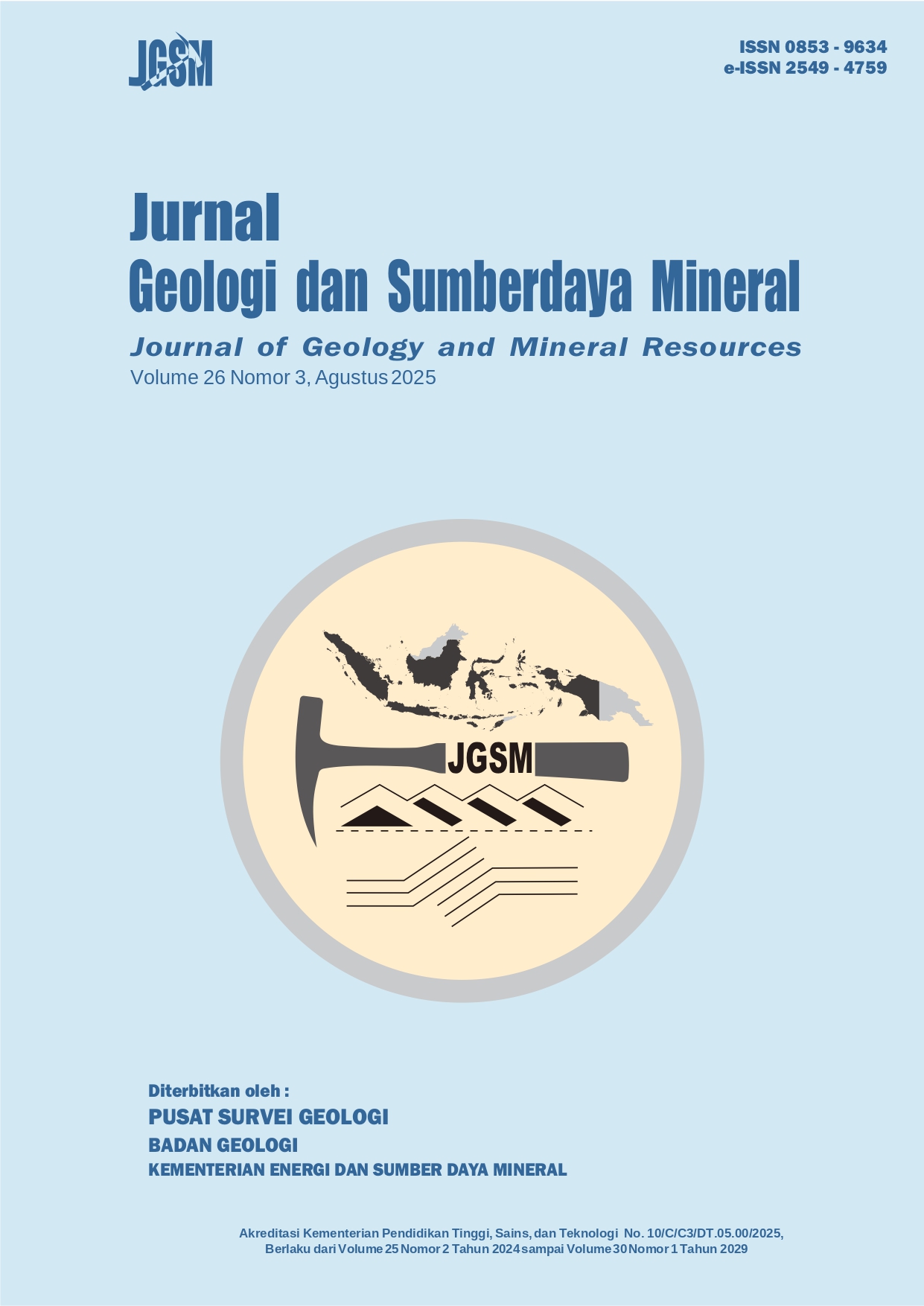Karakterisasi Spasial Struktur Bawah Permukaan Gunung Merapi dan Sekitarnya Menggunakan Tomografi Seismik
DOI:
https://doi.org/10.33332/jgsm.geologi.v26i3.987Abstract
Aktivitas vulkanik intensif di kawasan Gunung
Merapi memerlukan pemahaman mendalam terhadap
struktur bawah permukaan, terutama dalam konteks
mitigasi bahaya erupsi dan analisis sistem magmatik.
Namun, keterbatasan resolusi spasial pada studi tomografi
sebelumnya menyulitkan identifikasi detail struktur seperti
reservoir magma dangkal, zona rekahan, dan sesar aktif yang
berperan dalam suplai magma. Oleh karena itu, penelitian
ini bertujuan untuk mengidentifikasi dan mengkarakterisasi
struktur bawah permukaan Gunung Merapi dan wilayah
sekitarnya secara spasial melalui tomografi seismik berbasis
kecepatan gelombang P (Vp), gelombang S (Vs), dan
rasio Vp/Vs. Data seismik lokal yang digunakan berasal
dari jaringan broadband DOMERAPI dan BMKG, yang
diolah menggunakan perangkat lunak LOTOS-13 dengan
pemodelan inversi non-linier. Hasil inversi menunjukkan
adanya zona anomali kecepatan rendah dengan rasio Vp/
Vs tinggi pada kedalaman <6 km di bawah Merapi, yang
diinterpretasikan sebagai reservoir magma dangkal yang
kaya fluida. Zona transisi dan reservoir magma menengah
teridentifikasi masing-masing pada kedalaman 6–12 km dan
13–16 km. Di bawah Gunung Merbabu, anomali kecepatan
lebih lemah tanpa indikasi aktivitas magmatik signifikan,
mencerminkan sistem vulkanik yang relatif tidak aktif.
Selain itu, zona kecepatan rendah dan rasio Vp/Vs tinggi
pada kedalaman 15–18 km di selatan Merapi dikaitkan
dengan keberadaan Sesar Opak. Hasil studi ini memperkuat
pemahaman mengenai dinamika sistem magmatik serta
potensi seismotektonik di kawasan vulkanik Jawa Tengah.
Kata Kunci: Tomografi seismik, Gunung Merapi, Struktur
bawah permukaan, rasio Vp/Vs, Reservoir Magma
Abstract
Intense volcanic activity in the Mount Merapi
region necessitates a thorough understanding of its
subsurface structure, particularly for eruption hazard
mitigation and magmatic system analysis. However,
limitations in spatial resolution from previous tomography
studies have hindered detailed identification of features
such as shallow magma reservoirs, fracture zones, and
active faults responsible for magma transport. Therefore,
this study aims to identify and spatially characterize
the subsurface structure beneath Mount Merapi and its
surroundings using seismic tomography based on P-wave
velocity (Vp), S-wave velocity (Vs), and Vp/Vs ratio data.
Local seismic data were obtained from the DOMERAPI
and BMKG broadband networks and processed using the
LOTOS-13 software with a non-linear inversion model. The
results reveal a low-velocity anomaly zone with a high Vp/Vs
ratio at depths of less than 6 km beneath Merapi, interpreted
as a shallow, fluid-rich magma reservoir. A transition zone
and an intermediate magma reservoir were identified at
depths of 6–12 km and 13–16 km, respectively. Beneath
Mount Merbabu, weaker velocity anomalies without
significant magmatic signals indicate a relatively inactive
volcanic system. Additionally, low-velocity and high Vp/
Vs ratio zones at depths of 15–18 km south of Merapi are
associated with the Opak Fault. These findings enhance our
understanding of magmatic dynamics and seismotectonic
potential in the Central Java volcanic region.
Keywords: Seismic tomography, Mount Merapi, Subsurface
structure, Vp/Vs ratio, Magma reservoir
Downloads
Downloads
Published
Issue
Section
License
Copyright (c) 2025 Joshua Purba, Riska Yulinda

This work is licensed under a Creative Commons Attribution-NonCommercial 4.0 International License.
Authors who publish articles in Jurnal Geologi dan Sumberdaya Mineral (JGSM.Geologi) agree to the following terms:
- Authors retain copyright of the article and grant the journal right of first publication with the work simultaneously licensed under a CC-BY-NC or The Creative Commons Attribution–ShareAlike License.
- Authors are able to enter into separate, additional contractual arrangements for the non-exclusive distribution of the journal's published version of the work (e.g., post it to an institutional repository or publish it in a book), with an acknowledgment of its initial publication in this journal.
- Authors are permitted and encouraged to post their work online (e.g., in institutional repositories or on their website) prior to and during the submission process, as it can lead to productive exchanges, as well as earlier and greater citation of published work (See The Effect of Open Access)










